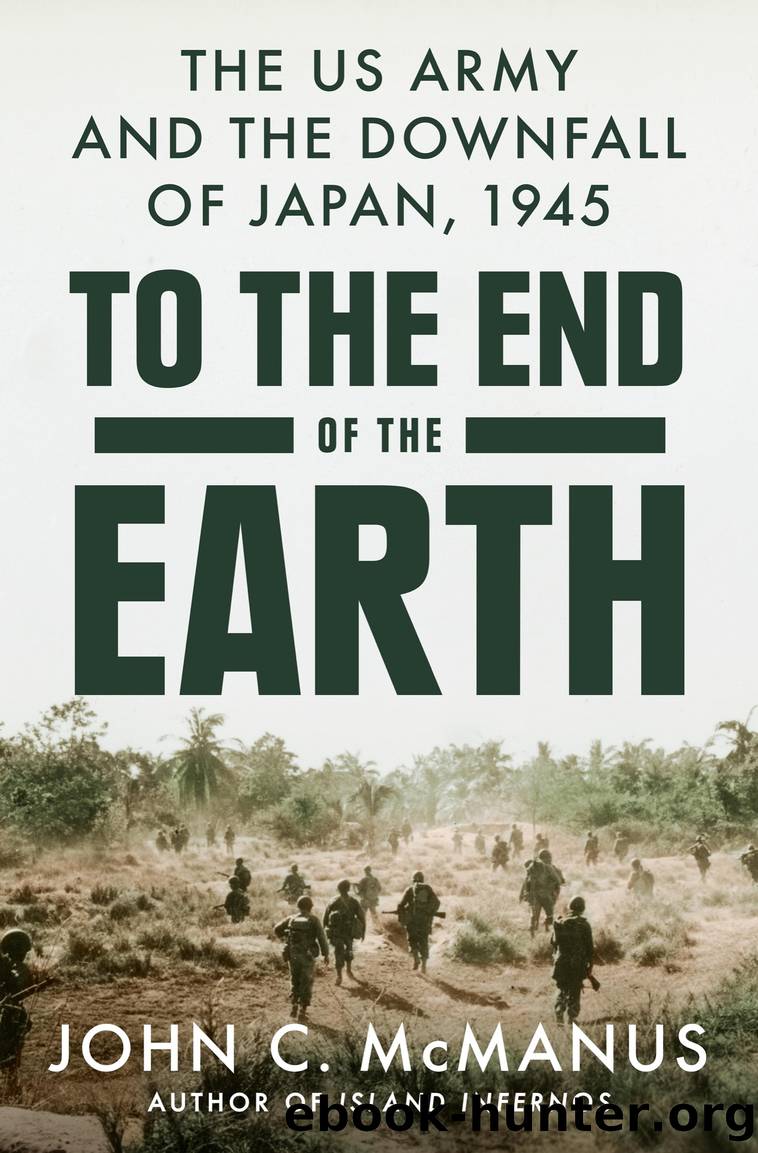To the End of the Earth by John C. McManus

Author:John C. McManus [McManus, John C.]
Language: eng
Format: epub
Publisher: Penguin Publishing Group
Published: 2023-05-02T00:00:00+00:00
* * *
The rhythm of this deathly close combat soon centered around repeated assaults by highly exposed, numerically small tank-infantry teams. No single American weapon on Okinawa was more indispensable to the destruction of Japanese defenses than the tank, the first time that armor played such a prominent, starring role in a Pacific War battle. Indeed, General Ushijima asserted in a directive circulated throughout 32nd Army during the fighting that âthe enemyâs power lies in his tanks. It has become obvious that our general battle against the American forces is a battle against their . . . tanks.â In fact, Tenth Armyâs order of battle included enough Sherman medium tanks to populate a standard armored division in Europe, though the organization was markedly different. European theater armored divisions operated as combined arms entities with armored infantry, armored field artillery, armored engineers, and the like comprising a preponderance of the unitâs manpower. On Okinawa, the 20th Armored Group operated as a clearinghouse administrative headquarters overseeing four tank battalions and an armored flamethrower tank battalion, each of which operated independently in support of the infantry divisions (the order of battle also included three amphibious tank battalions and six amphibious tractor or LVT battalions that played a leading role in the invasion but less so after L Day).
The armored battalion commanders parceled out their tanks either platoon by platoon or company by company with attacking infantry battalions. âOn the platoon level, control and coordination took several forms,â a postwar Armor School study by a team of experienced tank officers related. âIf the tank turrets were open, voice or hand signals sufficed for target designation and direct contact. With turrets closed, the telephone attached to the back of each tank provided a ready means of communication.â Their teamwork depended too much on close proximity to one another. Far too often the infantrymen became separated from the tanks or pinned down alongside them. The two groups did not have direct radio contact with each other. To communicate in these circumstances, they had to relay radio messages up their respective chains of command, a time-consuming, inefficient process and one fraught with the potential for disastrous miscommunication or misunderstanding. Regardless, they formed a potent team, one that comprised the only real way to destroy Ushijimaâs defenses and gain ground. âThe number of these small units, each engaged in taking a certain pillbox, or of closing a certain cave, or of wiping out a machine gun, or of destroying an entrenched squad of Japanese by grenades, or of hurling satchel charges into a position that could not otherwise be reached, was multitudinous across the whole front,â Captain Roy Appleman, the XXIV Corps historian, wrote insightfully after personally witnessing weeks of combat. âEach little action was a desperate adventure in itself, and generally had to be executed in close coordination with the assaults of adjacent small units, each helping to neutralize action against the other. In general it was a fight that required many small groups to think out
Download
This site does not store any files on its server. We only index and link to content provided by other sites. Please contact the content providers to delete copyright contents if any and email us, we'll remove relevant links or contents immediately.
Waking Up in Heaven: A True Story of Brokenness, Heaven, and Life Again by McVea Crystal & Tresniowski Alex(37489)
Empire of the Sikhs by Patwant Singh(22767)
We're Going to Need More Wine by Gabrielle Union(18633)
Hans Sturm: A Soldier's Odyssey on the Eastern Front by Gordon Williamson(18327)
Leonardo da Vinci by Walter Isaacson(12804)
The Radium Girls by Kate Moore(11621)
Tools of Titans by Timothy Ferriss(7815)
Educated by Tara Westover(7690)
How to Be a Bawse: A Guide to Conquering Life by Lilly Singh(7156)
Permanent Record by Edward Snowden(5541)
The Last Black Unicorn by Tiffany Haddish(5414)
The Rise and Fall of Senator Joe McCarthy by James Cross Giblin(5148)
Promise Me, Dad by Joe Biden(4908)
The Wind in My Hair by Masih Alinejad(4843)
The Crown by Robert Lacey(4572)
A Higher Loyalty: Truth, Lies, and Leadership by James Comey(4552)
The Iron Duke by The Iron Duke(4122)
Joan of Arc by Mary Gordon(3783)
Stalin by Stephen Kotkin(3724)
